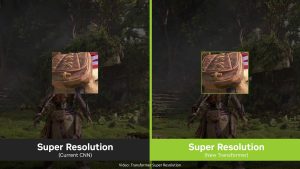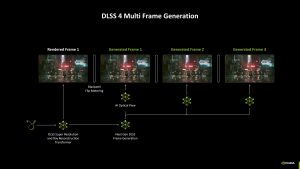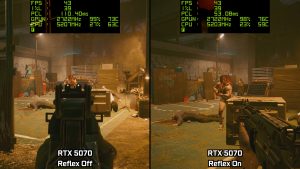PC gaming has changed significantly over the last few years, and while this is sponsored content, there's also no denying that NVIDIA has been at the forefront of that shift since the company's first RTX GPUs launched back in 2018. While raw GPU power is still important, NVIDIA is keen to emphasise the ‘three pillars of gaming': latency, frame rate and image quality.
In today's content, we're focusing on a range of NVIDIA gaming features, including Super Resolution, Frame Generation, Reflex and more, examining how they each offer different relationships with those three pillars of gaming. Super Resolution, for instance, renders at a lower resolution before using AI to upscale the final output – meaning an increase to frame rate, while image quality also varies compared to native rendering.
Frame Generation is also a key consideration for our video today, a technology which inserts AI-generated frames in-between traditionally rendered ones. This does have the effect of increasing latency, but it also boosts frame rate beyond what could be otherwise achieved. We also touch on the image quality of said AI-generated frames, while looking at Reflex – NVIDIA's technology to reduce PC latency.
For the full analysis, be sure to check out the video below, where we assess each key feature and the knock-on effect for frame rate, latency and image quality in game:
Closing Thoughts
As we said at the very start of this article, there’s no doubt PC gaming has changed massively over the last few years. The adoption of modern features means there is a lot more to the gaming experience now than just raw FPS, and it’s fascinating to see the interplay between the features we looked at today. Super Resolution, for instance, affects both latency, image quality and frame rate, while Frame Generation can add latency but also boost frame rates in a way that would otherwise be impossible. Then there’s Reflex which can mitigate that latency penalty.
Ultimately it comes down to the individual and what specific features and technologies you want to enable – and for me that is the beauty of PC gaming, as there’s no right or wrong way to do it.
Our testing today has focused on the latest and greatest features, including the likes of MFG, which is exclusive to the Blackwell architecture. As we saw from our testing with the 5060 Ti 16GB, the 5070 and the 5070 Ti, all three GPUs are able to offer a way of playing that you simply can’t achieve on older generations, particularly when looking at ray traced or path traced experiences in the latest AAA games.
KitGuru says: Let us know which features you use regularly!
 KitGuru KitGuru.net – Tech News | Hardware News | Hardware Reviews | IOS | Mobile | Gaming | Graphics Cards
KitGuru KitGuru.net – Tech News | Hardware News | Hardware Reviews | IOS | Mobile | Gaming | Graphics Cards






